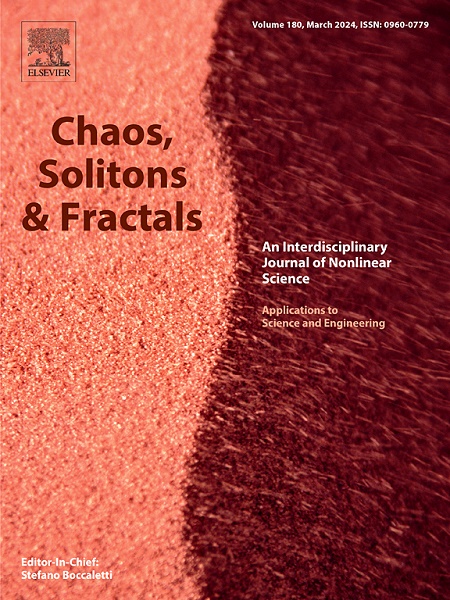Contagion dynamics on growing simplicial complex networks via generalized degree vectors
IF 5.3
1区 数学
Q1 MATHEMATICS, INTERDISCIPLINARY APPLICATIONS
引用次数: 0
Abstract
To reveal the influence of group interactions on contagion, and to accurately prevent and regulate contagion, this paper investigates the SIS contagion dynamics in complex networks with high-order interactions. First, this paper considers the synergistic effects of the first-order and second-order generalized degree of each node and proposes a novel algorithm to construct growing second-order simplicial complex networks based on generalized degree vectors, named GDV-GSC algorithm. The first-order and second-order generalized degree distributions of the networks newly achieved show heterogeneity. Then, using the microscopic Markov chain approach (MMCA), some SIS MMCA dynamics equations in the GDV-GSC network have been obtained. Monte Carlo (MC) results and MMCA numerical simulations confirm that the MMCA theoretical results are feasible and effective, and also indicate that the parameters for generating GDV-GSC network have limited effect on the contagion spreading when the effective contagion rate is either very low or very high. Further, a new method that is heterogeneous mean field approximation based on simplicial complex (called SC-HMF) to obtain epidemic threshold expressions is put forward. The MC simulation results verify the accuracy of the epidemic threshold expression and the occurrence of a bistability phenomenon, where the absorbing state and the bursting state coexist within a certain range of effective infectivity rates. Moreover, the second-order simplicial complex structures in the GDV-GSC network play a key role in determining the epidemic threshold.
基于广义度向量的生长简单复杂网络传染动力学
为了揭示群体相互作用对传染的影响,准确地预防和调控传染,本文研究了具有高阶相互作用的复杂网络中的SIS传染动力学。首先,考虑到各节点一阶和二阶广义度的协同效应,提出了一种基于广义度向量构建增长二阶简单复杂网络的新算法——GDV-GSC算法。新得到的网络的一阶和二阶广义度分布具有异质性。然后,利用微观马尔可夫链方法(MMCA),得到了GDV-GSC网络中的一些SIS MMCA动力学方程。Monte Carlo (MC)结果和MMCA数值模拟证实了MMCA理论结果的可行性和有效性,也表明在有效传染率非常低或非常高时,生成GDV-GSC网络的参数对传染传播的影响有限。在此基础上,提出了一种基于简单复合体的异质平均场近似(SC-HMF)求流行病阈值表达式的新方法。MC模拟结果验证了流行阈值表达式的准确性,并验证了在一定有效传染率范围内,存在吸收状态和爆发状态并存的双稳态现象。此外,GDV-GSC网络中的二阶简单复杂结构在确定流行阈值方面起着关键作用。
本文章由计算机程序翻译,如有差异,请以英文原文为准。
求助全文
约1分钟内获得全文
求助全文
来源期刊

Chaos Solitons & Fractals
物理-数学跨学科应用
CiteScore
13.20
自引率
10.30%
发文量
1087
审稿时长
9 months
期刊介绍:
Chaos, Solitons & Fractals strives to establish itself as a premier journal in the interdisciplinary realm of Nonlinear Science, Non-equilibrium, and Complex Phenomena. It welcomes submissions covering a broad spectrum of topics within this field, including dynamics, non-equilibrium processes in physics, chemistry, and geophysics, complex matter and networks, mathematical models, computational biology, applications to quantum and mesoscopic phenomena, fluctuations and random processes, self-organization, and social phenomena.
 求助内容:
求助内容: 应助结果提醒方式:
应助结果提醒方式:


